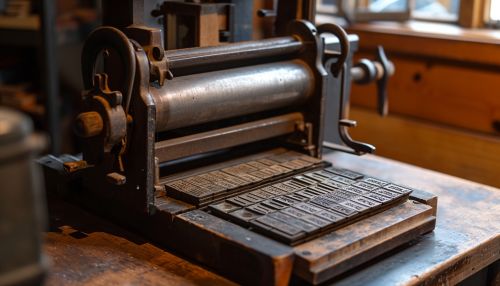Publishing
Overview
Publishing is the process of production and dissemination of literature, music, or information—the activity of making information available to the general public. Traditionally, the term refers to the distribution of printed works, such as books, newspapers, and magazines. With the advent of digital information systems and the Internet, the scope of publishing has expanded to include electronic resources, such as the electronic versions of books and periodicals, as well as micropublishing, websites, blogs, video game publishers, and the like.
History
The history of publishing is characterized by a close interplay of technical innovation and social change, each promoting the other. Publishing as it is known today depends on a series of three major inventions—writing, paper, and printing—and one crucial social development—the spread of literacy.
Writing
Before the invention of writing, perhaps by the Sumerians in the 4th millennium BC, information could be spread only by word of mouth, with all the inherent limitations of place and time. Writing was originally regarded not as a means of disseminating information but as a way to fix religious formulations or to secure codes of law, genealogies, and other socially important matters, which had previously been committed to memory.
Paper
Publishing could begin only after the monopoly of letters, often held by a priestly caste, had been broken, probably in connection with the development of the value of writing in commerce. Scripts of various kinds came to be used throughout most of the ancient world for proclamations, correspondence, transactions, and records; but book production was confined largely to religious centres of learning, as it would be again later in medieval Europe. Only in Hellenistic Greece, in Rome, and in China, where there were essentially nontheocratic societies, does there seem to have been any publishing in the modern sense—i.e., a copying industry supplying a lay readership.
Printing
The invention of printing transformed the possibilities of the written word. Printing seems to have been first invented in China in the 6th century AD in the form of block printing. An earlier version may have been developed at the beginning of the 1st millennium BC, but, if so, it soon fell into disuse. The Chinese invented movable type in the 11th century AD but did not fully exploit it. Other Chinese inventions, including paper (105 AD), were passed on to the West but not, it seems, printing. The reason may have been the enormous number of Chinese ideograms, which prevented the type from being cast in bulk.


Modern Publishing
In the modern era, the process of publishing book typically involves these stages:
- Acquisition - Copy editing - Production - Printing (and its electronic equivalents) - Marketing - Distribution
These processes are applied to both traditional publishing and self-publishing.
Acquisition
The process of acquisition begins with the author proposing a book that they would like to write or that they have already written, and ends with the decision to publish the book. The process can take months, if not years, depending on the publisher and the quality of the manuscript.
Copy Editing
Once the book is acquired, it goes through the process of copy editing. This is where the manuscript is reviewed for grammatical, stylistic, and factual errors. The copy editor also ensures that the book fits the publisher's style and adheres to the industry's standards.
Production
After the copy editing is complete, the book goes into production. This is where the book is designed, typeset, and prepared for printing. The production process can take anywhere from a few weeks to a few months, depending on the complexity of the book and the publisher's schedule.
Printing
Once the book is ready for printing, it is sent to the printer. The printer prints, binds, and trims the book to its finished size. The printing process can take anywhere from a few days to a few weeks, depending on the quantity of books being printed and the printer's schedule.
Marketing
While the book is being printed, the publisher begins the process of marketing the book. This includes creating a marketing plan, designing promotional materials, and scheduling promotional events. The marketing process can take anywhere from a few weeks to a few months, depending on the publisher's resources and the book's target audience.
Distribution
Once the book is printed and the marketing materials are ready, the book is distributed. This includes shipping the books to bookstores, libraries, and other retailers, as well as fulfilling individual orders. The distribution process can take anywhere from a few days to a few weeks, depending on the size of the print run and the distribution channels.
See Also
Book Publishing Process Self-Publishing Process E-Publishing
